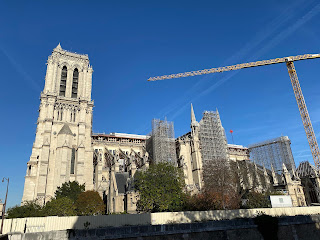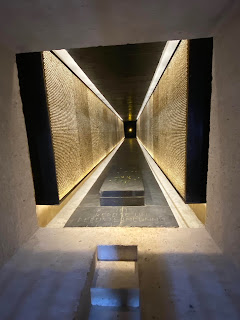The most famous Cathedral in Paris, Notre Dame, sits the east end of the most famous island in the Seine River, il de la cite.
The grand cathedral is currently in the midst of a many millions of Euros makeover. It will be closed for years.
Behind the soaring cathedral on the very eastern tip of the island is the Holocaust Deportation Memorial. The entire memorial to the 200,000 Jews deported to death camps is underground.

The entrance is a steep stone staircase down to an open area with a barred opening looking east along the Seine. East is, of course, the direction of transport the victims took to their death.
For me, the beautiful view of the Seine through iron bars is what deportation would look like--passing through a beautiful countryside in a cage.
In the summer when the setting sun is north of west the shadow of the cathedral falls on the Holocaust memorial, not for long, just minutes. I was overcome with sadness the first time I visited this memorial in 2017. I was in Paris in late June and early July and saw the shadow fall on the memorial after 9pm near sunset. During the Nazi era, 400 million Christian labeled people were either participants, complicit in or ignored the Holocaust.

The death camps are listed in blood red.
The barred opening seen from the north bank of the river is just a dark rectangle on a gray wall.
Another map shows all the Nazi camps to which people were sent to die.IN the midst of the memorial is a flame of remembrance.
The view to the east up the Seine River is lovely.
The open courtyard of the memorial feels very vertical and forbidding.
Inside is a long tunnel with names of the victims.
Each time I visit Paris I visit the memorial to those deported. Usually there are just a few people inside.
A few hundred meters away thousands are usually visiting Notre Dame. Even now dozens of people were looking at the posters on the walls enclosing the cathedral during its restoration.
















No comments:
Post a Comment